Abstract
This study focuses on the Hailijing sandstone-hosted uranium deposit in the Songliao Basin. Through a combination of petrographic analysis, X-ray diffraction (XRD), scanning electron microscopy (SEM), and geochemical analysis, the epigenetic alteration of the deposit was systematically investigated, and the alteration zonation was delineated. On this basis, the metallogenic mechanisms were further explored. The results indicate that six major types of alteration can be identified in the ore-bearing strata of the Hailijing uranium deposit: hematitization, limonitization, carbonatization, pyritization, clay mineralization (including kaolinite, illite, and illite-smectite mixed-layer), and baritization. The mineral assemblages at different stages of alteration vary: during the sedimentary diagenetic stage, the assemblage consists of “hematite + clay minerals + II-type pyrite (framboidal pyrite) + III-type pyrite (euhedral granular pyrite)”; during the uranium mineralization stage, it transitions to “ankerite + barite + I-type pyrite (colloidal pyrite) + minor kaolinite”; and in the post-ore stage, alteration is characterized by calcite cementation in red sandstones. Based on petrological, mineralogical, and geochemical characteristics, as well as the spatial distribution of the host gray sandstones, it is inferred that during uranium mineralization stage, the ore-bearing strata underwent reduction by uranium-rich reducing fluids sourced from the Lower Cretaceous Jiufotang Formation. The primary red sandstones of the Lower Yaojia Formation, formed under arid to semi-arid conditions, experienced varying degrees of reduction, resulting in a color transition from light red, brownish red, and yellowish brown to grayish-yellow and gray. Accordingly, four alteration zones are distinguished in the Hailijing uranium deposit: the primary red zone, weakly reduced pink zone, moderately reduced grayish-yellow zone, and strongly reduced gray zone. Furthermore, as the uranium-rich reducing fluids migrated from a high-temperature, high-pressure deep system to the low-temperature, low-pressure ore-bearing sandstone strata near the surface, uranium was unloaded, precipitated, and enriched, ultimately forming multi-layered and tabular-shaped uranium orebodies within the gray sandstone. This study elucidates the epigenetic alteration processes and metallogenic mechanisms of the Hailijing uranium deposit, providing a critical theoretical basis for further uranium exploration in the southern Songliao Basin.
1. Introduction
Sandstone-hosted uranium deposits have become one of the most significant uranium deposit types worldwide due to their shallow burial depth, large scale, suitability for in situ leaching, and low mining costs. Their formation is closely related to the depositional environment of sandstones, tectonic evolution, and subsequent fluid activities [1,2,3]. The genesis of these deposits typically involves complex epigenetic alteration processes, including the recrystallization, metasomatism, and decomposition of uranium minerals and associated minerals (e.g., pyrite, calcite, and clay minerals), accompanied by element migration and redistribution. In particular, the migration and distribution of elements such as Mo, V, Re, and rare earth elements (REEs) are crucial for understanding the nature and evolution of ore-forming fluids [4]. Furthermore, epigenetic alteration can modify the mineralogical and geochemical characteristics of uranium orebodies, leading to secondary modifications of the deposit morphology and increased complexity in metallogenic mechanisms [5,6]. Therefore, the epigenetic alteration study of sandstone-hosted uranium deposits not only enhances our understanding of ore-forming fluids and mineralization mechanisms but also provides essential guidance for exploration and resource assessment [4,6].
In recent years, significant breakthroughs have been made in the exploration of sandstone-hosted uranium deposits in the Qianjiadian area of southwestern Songliao Basin, leading to the discovery and delineation of a series of large uranium deposits. This has opened a new frontier for uranium exploration in Meso-Cenozoic continental sedimentary basins in northeastern China. Researchers have investigated the metallogenic characteristics and models of uranium mineralization in the Qianjiadian area from multiple perspectives, including regional metallogenic conditions, tectonic evolution, depositional characteristics of uranium-bearing strata, uranium mineral occurrences, and metallogenic chronology. Some scholars support the interlayer oxidation zone model, suggesting that the ore-forming fluids were primarily uranium-bearing oxidizing fluids derived from meteoric water. These oxidized, uranium-rich bicarbonate waters migrated through permeable sandstones confined by overlying and underlying mudstone aquitards, leading to uranium precipitation and ore formation via interlayer oxidation infiltration [7,8]. However, other researchers propose alternative models, arguing that uranium mineralization resulted from a combination of interlayer oxidation and deep-seated fluids, such as mafic magmatic hydrothermal fluids, hydrocarbons, or natural gas [9,10,11]. Thus, the genetic model for sandstone-hosted uranium deposits in the Qianjiadian area remains unresolved.
In light of these uncertainties, this study focuses on the Hailijing sandstone-hosted uranium deposit in the Songliao Basin. From the perspective of epigenetic alteration, we aim to clarify the alteration types and mineral assemblages, establish the mineral alteration sequence, and delineate alteration zonation within the ore-bearing strata. This research provides petrological and geochemical constraints on the genetic mechanisms of the deposit and offers theoretical support for further sandstone-hosted uranium exploration in the region.
2. Geological Settings
The Songliao Basin is a Mesozoic continental petroliferous basin with a fault-subsidence composite structure, situated atop a cratonic basement (Figure 1a). Tectonically, it is located at the intersection of the Paleo-Asian Ocean and Paleo-Pacific–Pacific tectonic domains [12], extending in a NE–SW direction. Its evolution can be divided into three major stages: The Late Jurassic (J3)–Early Cretaceous (K1) rift stage, the Late Cretaceous (K2) depression stage, and the subsequent tectonic inversion stage. During the rift stage, more than 30 fault-controlled sub-basins of varying scales formed within the Songliao Basin, accompanied by multiple coal-bearing clastic-volcanic sedimentary sequences. The depression stage was a critical period for the deposition of key potential uranium-bearing target formations, including the Quantou Formation (K2q), Qingshankou Formation (K2qn), and Yaojia Formation (K2y). Tectonic inversion occurred during the late Nenjiang (K2n) and late Mingshui (K2m) periods, resulting in uplift and the formation of decompression zones within sandstones of different stratigraphic levels and lithologies. These decompression zones provided favorable conditions for the large-scale migration and exfiltration of uranium-bearing fluids, facilitating uranium mineralization at depth.
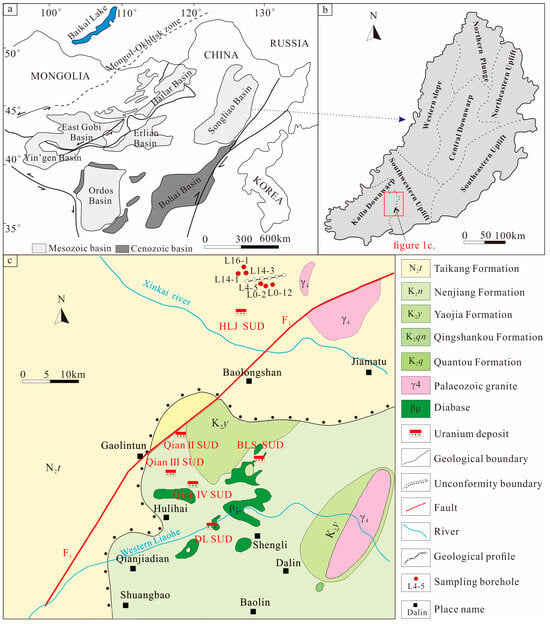
Figure 1.
Structural map of Mesozoic and Cenozoic sedimentary basins in north China (a) (modified from Bonnetti et al., 2014 [13]; Ren et al., 2022 [11]; Chen et al., 2023 [14]); tectonic unit map of the Songliao Basin (b); the geological map of the Qianjiadian area (c). BLS SUD-Baolongshan sandstone-hosted uranium deposit; DL SUD-Dalin sandstone-hosted uranium deposit; HLJ SUD-Hailijin sandstone-hosted uranium deposit; Qian II SUD-Qian II sandstone-hosted uranium deposit; Qian III SUD-Qian III sandstone-hosted uranium deposit; Qian IV SUD-Qian IV sandstone-hosted uranium deposit.
The Songliao Basin can be subdivided into seven first-order tectonic units: The Northern Plunge, Central Downwarp, Northeastern Uplift, Southeastern Uplift, Southwestern Uplift, Western Slope, and Kailu Downwarp (Figure 1b). These units further comprise various sags and swells. The Hailijing uranium deposit is located at the transitional zone between the Southwestern Uplift and the Kailu Downwarp, along the margin of the Qianjiadian Sag (Figure 1c). The pre-Mesozoic basement fault in the mining area is developed, among which the F1 fault in the southeastern part is most closely associated with the Hailijing uranium deposit (Figure 1c). The F1 fault was initially a normal fault, and it transformed into a thrust fault due to the tectonic inversion during the late Nenjiang. This structural inversion led to the uplift and erosion of strata in the mining area, forming the Baolongshan structural erosion window. Additionally, the F1 fault penetrates the basement, providing a favorable conduit for the exfiltration and migration of deep-seated reducing fluids.
Drilling data from the mining area reveals the presence of several stratigraphic units, including the Upper Cretaceous Qingshankou Formation (K2qn), Yaojia Formation (K2y), Nenjiang Formation (K2n), Sifangtai Formation (K2s), Neogene Taikang Formation (N2t), and Quaternary deposits. The Hailijing uranium deposit is hosted within gray sandstones of the Lower Yaojia Formation (K2y1), which is part of a red-mottled sedimentary construction. The oxidized rocks, exhibiting colors ranging from bright red, light red, and reddish-brown to brownish-red and yellowish-brown. Yellowish sandstones are relatively rare and typically appear as transitional hues, such as grayish-yellow sandstones (Figure 2 and Figure 3). In contrast, the gray sandstones are reduced rocks, with colors including gray, grayish-white, and grayish-green (Figure 2 and Figure 3). Vertically, these gray sandstones occur as lenticular or bead-like bodies suspended within the red-mottled sedimentary construction. The uranium orebodies primarily exhibit as tabular shaped and display multi-layered characteristics (Figure 4) [15,16].
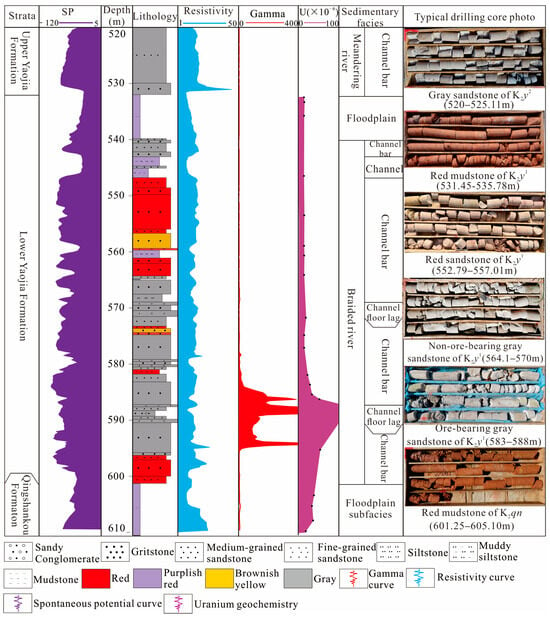
Figure 2.
Comprehensive stratigraphic column diagram of the ore-bearing strata of the Hailijin uranium deposit (modified from Tian et al., 2023 [15]).
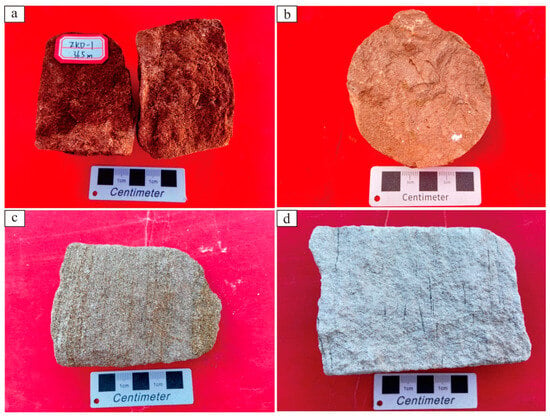
Figure 3.
Macroscopic characteristics of different rock types in the Hailijing uranium deposit. (a) bright red medium-grained sandstone; (b) light red fine-grained sandstone; (c) yellowish-brown medium-grained sandstone; (d) gray medium-grained sandstone containing black organic matter.
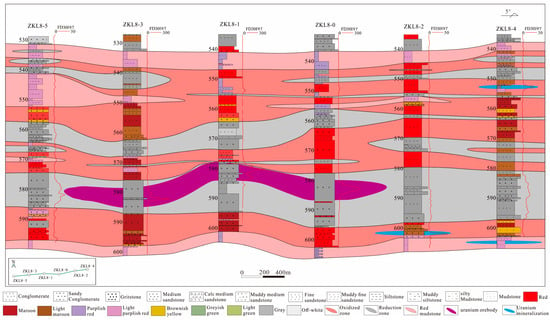
Figure 4.
NEE direction geological profile in the Hailijin uranium deposit (Geological profile position is shown in Figure 1).
3. Analytical Methods
To systematically investigate the alteration characteristics of the Hailijing uranium deposit, representative red-mottled sandstones and gray sandstones were systematically sampled from key drill cores (sampling locations shown in Figure 1). All petrographic, geochemical, X-ray diffraction (XRD), and scanning electron microscopy (SEM) analyses were conducted at the Analytical and Testing Center of the Beijing Research Institute of Uranium Geology. The specific analytical methods are as follows:
- (1)
- Petrographic Identification
Petrographic analyses were performed using a Leica DM4P transmitted-reflected polarized microscope and a Zeiss Axioskop 40 transmitted-fluorescence microscope, which both instruments are manufactured in Germany. These analyses focused on identifying the mineral composition, textures, structures, and alteration of mineral assemblages in the samples.
- (2)
- Major and Trace Element Analysis
Major element compositions were analyzed using an AB104L Axios-mAX (manufactured by PANalytical B.V.) wavelength-dispersive X-ray fluorescence (XRF) spectrometer, with an analytical precision better than 5%. Trace element analysis was conducted using an ELEMENT XR inductively coupled plasma mass spectrometer (ICP-MS) which manufactured by Germany Finnigan MAX Company. Prior to analysis, samples were crushed to 200 mesh, and 0.5 g of each sample was dissolved in nitric acid for measurement. The analytical precision was better than 3%. Throughout the experiment, laboratory conditions were maintained at a temperature of 25 °C and a relative humidity of 24%.
- (3)
- X-Ray Diffraction (XRD) Analysis
XRD analysis was performed using a Panalytical X’PROMPD diffractometer (the instrument manufactured in Japan) following the industry standards SY/T 5163-1995 [17]. The operating conditions included a voltage of 40 kV and a current of 40 mA, with a Cu target as the X-ray source. The scanning angle ranged from 3° to 30°.
- (4)
- Scanning Electron Microscopy (SEM)
SEM analysis was conducted using a Nova Nano SEM450 (the instrument manufactured in America) scanning electron microscope, strictly following the guidelines of JY/T 0584-2020 [18]. The instrument was operated at an accelerating voltage of 20 kV and a beam current of 100 pA. Elemental composition analysis was performed using an EDAX-GENESIS energy-dispersive spectrometer (EDS), following the standard JY/T 010-1996 [19].
4. Results
4.1. Types of Alteration Minerals
Based on detailed petrographic identification, scanning electron microscopy (SEM), whole-rock X-ray diffraction (XRD), and clay mineral analysis, six types of alteration minerals have been identified in the Lower Yaojia Formation of the Hailijing uranium deposit. These include hematitization, limonitization, carbonatization, pyritization, clayization, and baritization.
- (1)
- Hematitization
Hematitization is typically characterized by the presence of abundant hematite, imparting a reddish coloration to the rock. In the Hailijing uranium deposit, hematite occurs either as colloidal fillings along the edges of quartz and feldspar clastic grains (Figure 5a) or as infill within the matrix (Figure 5b). Under reflected light microscopy, hematite exhibits a distinct dark red hue (Figure 5c). Petrographic analysis reveals that hematitization is most intense in bright red sandstones and red mudstones, followed by pale red and reddish-brown sandstones, with weaker alteration observed in brownish-yellow and grayish-yellow sandstones. Additionally, in the gray sandstones, hematite commonly appears as discrete spots along the edges of detrital grains or within the matrix (Figure 5d). Overall, the intensity of hematitization exhibits a clear decreasing trend in the sequence: bright red sandstone → pale red and reddish-brown sandstone → brownish-yellow and grayish-yellow sandstone → ore-bearing gray sandstone.
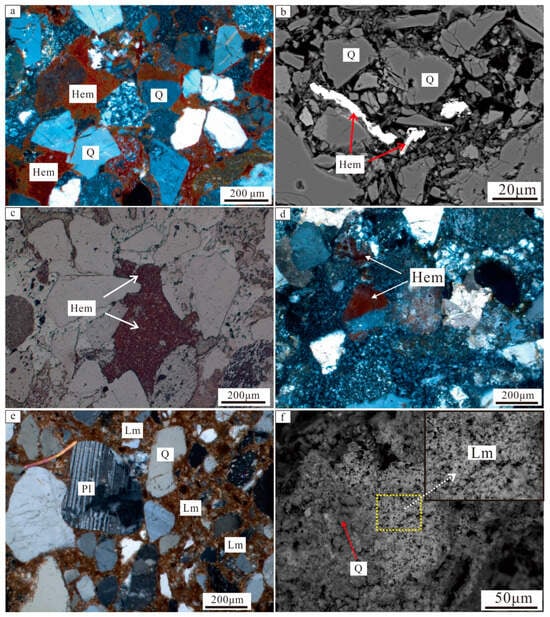
Figure 5.
Hematitization and ferritization of the Lower Yaojia formation in the Hailijin uranium deposit. (a) Gel-like hematite fills the edges of quartz, feldspar, and other clastic particles, as well as the intergranular pores (cross-polarized light); (b) hematite is filled within the matrix of the cementing material (backscattered electron image); (c) under reflected light, hematite appears brownish-red; (d) hematite spots are observed in the gray sandstone, suggesting that the gray sandstone may have undergone later-stage reduction alteration, with the hematite spots representing remnants of incomplete reduction (cross-polarized light); (e) in the yellow sandstone, limonite is present in a gel-like form within the intergranular pores (cross-polarized light); (f) under scanning electron microscopy, needle-like jarosite occurs on the surface of clastic particles (backscattered electron image). Hem—hematite, Lm—limonite, Pl—plagioclase, Q—quartz.
- (2)
- Limonitization
Limonitization is commonly observed in brownish-yellow and grayish-yellow sandstones, occurring in colloidal or granular forms (Figure 5e). Studies have shown that limonite is a mixture of iron hydroxides, including goethite, lepidocrocite, and jarosite, with the content and degree of mixing of goethite and lepidocrocite being the primary factors influencing the yellow coloration of the rock [20]. Under scanning electron microscopy (SEM), mixtures of goethite and lepidocrocite are observed filling intergranular spaces or coating the surfaces of feldspar and quartz clasts (Figure 5f). Additionally, localized limonitization is occasionally found along the edges of pyrite grains, indicating that limonitization is a post-diagenetic alteration process.
- (3)
- Carbonatization
Carbonatization can be divided into three types: ankerite, calcite, and siderite. Ankerite is commonly found in the mineralized gray sandstones, either distributed in a granular or mosaic pattern within the intergranular porosity of clastic grains (Figure 6a) or replacing clastic grains along their edges in the form of cement (Figure 6b). Pitchblende often grows along the edges of ankerite, forming a pitchblende rim structure (Figure 6c), indicating that the timing of ankerite cementation closely coincides with a certain stage of uranium mineralization, suggesting that ankerite is a mineral formed during the ore-forming period. Calcite is commonly observed in red sandstones and can be divided into two categories: one, where calcite fills the intergranular porosity between clastic mineral grains as a cementing material (Figure 6d), and another, where it forms semi-subhedral to euhedral granular fillings within pores (Figure 6e). This indicates that the calcite in these red sandstones is a product of post-diagenetic alteration. Sporadic calcite is also observed in the ore-bearing gray sandstones. Siderite is rarely observed in the mineralized gray sandstones and is often replaced by ankerite, indicating that the formation of siderite predates that of ankerite (Figure 6f).
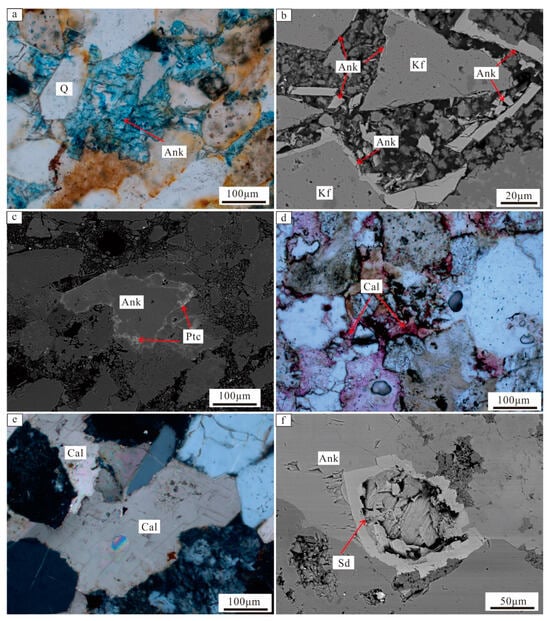
Figure 6.
Carbonatization of the Lower Yaojia formation in the Hailijin uranium deposit. (a) In the mineralized gray sandstone, ankerite is commonly observed, and the stained ankerite appears light blue (plane-polarized light); (b) ankerite alters the edges of potassium feldspar (backscattered electron image); (c) pitchblende grows along the edge of the ankerite, forming a pitchblende-bordered structure, indicating that uranium mineralization and the formation of ankerite cementation occurred around the same time (backscattered electron image); (d) the stained calcite appears orange-red and fills the pores between detrital mineral particles as a cementing material (plane-polarized light); (e) in the red sandstone, subhedral to euhedral granular calcite fills the intergranular pores of the detrital particles (cross-polarized light); (f) a small amount of siderite is found in the mineralized gray sandstone, with the siderite edges being altered by ankerite, indicating that the formation of ankerite occurred later than siderite (backscattered electron image). Ank—ankerite, Cal—calcite, Kf—potassium feldspar, Ptc—pitchblende, Q—quartz, Sd—siderite.
- (4)
- Pyritization
Pyritization is commonly observed in the gray sandstones, including colloidal pyrite (I-type), framboidal pyrite (II-type), and euhedral granular pyrite (III-type) (Figure 7a–d) [16]. I-type and II-type pyrite are dominant and are often irregularly distributed in the intergranular pores of clastic particles, dissolution pores in rock fragments, and within organic matter. Some pyrite grains display growth ring structures, with the core being II-type pyrite and the outer edges consisting of I-type pyrite (Figure 7a), indicating at least two phases of pyrite. I-type pyrite is commonly associated with pitchblende (Figure 7e), or the two minerals coexist within organic matter, forming the “pitchblende + pyrite + organic matter” assemblage, which suggests that these pyrite types are products of the mineralization phase. Additionally, microscopic and nanoscale uraninite is occasionally observed adhering to the surface of II-type pyrite (Figure 7f). III-type pyrite primarily forms cubic and dodecahedral shapes, occurring in a relatively closed diagenetic environment, and is considered a product of the diagenetic stage.
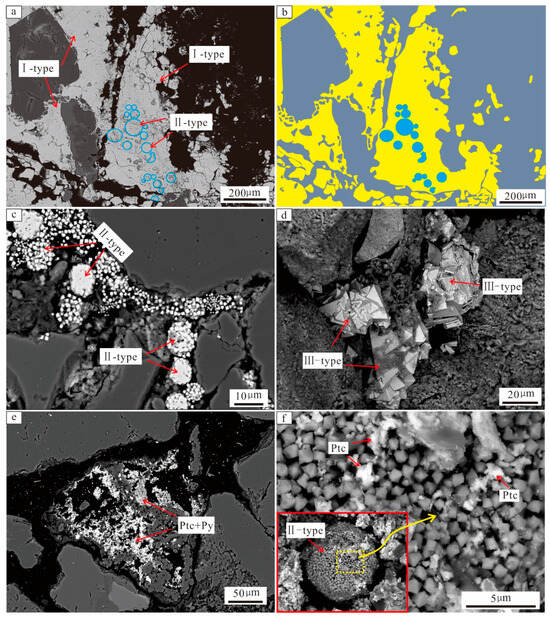
Figure 7.
Pyritization of the Lower Yaojia formation in the Hailijin uranium deposit. (a) Ring-like zoned pyrite, with a II-type pyrite core and a I-type pyrite outer zone, indicating at least two stages of pyrite formation (backscattered electron image); (b) explanatory diagram of the photograph (a), the yellow areas represent I-type pyrite, while the blue areas indicate the II-type pyrite, the gray part denotes other minerals and pores; (c) II-type pyrite fills the intergranular pores between clastic particles (backscattered electron image); (d) III-type pyrite fills the intergranular pores between clastic particles (backscattered electron image); (e) I-type pyrite is co-associated with pitchblende (backscattered electron image); (f) the surface of II-type pyrite adsorbs micrometer-sized pitchblende (backscattered electron image). I-type represents colloidal pyrite, II-type represents framboidal pyrite, III-type represents euhedral granular pyrite. Ptc—pitchblende, Py—pyrite.
- (5)
- Clay alteration
The ore-bearing sandstones of the Hailijin uranium deposit commonly exhibit clayization, with kaolinite and sericite being the most prevalent, followed by illite-smectite mixed layers (I/S) and illite. Sericitization is observed in sandstones of various colors, primarily manifesting as fine sericite formation along the core of plagioclase (Figure 8a). Kaolinite primarily occurs as book-like or flaky aggregates within the intergranular pores of clastic particles (Figure 8b). XRD analysis indicates that the content of kaolinite in the host gray sandstones and ores is significantly higher than that in other-colored sandstones (Table 1). Uranium minerals are closely associated with kaolinite, with uranium often appearing in the form of microcrystals, microcrystalline aggregates, or nanoscale pitchblende, adsorbed onto the surface of book-like kaolinite or within its intergranular pores (Figure 8c). Illite mainly appears as small flaky or plate-like aggregates on the surface of clastic particles or within intergranular pores (Figure 8d). I/S and montmorillonite are rarely observed in the Hailijin uranium deposit.
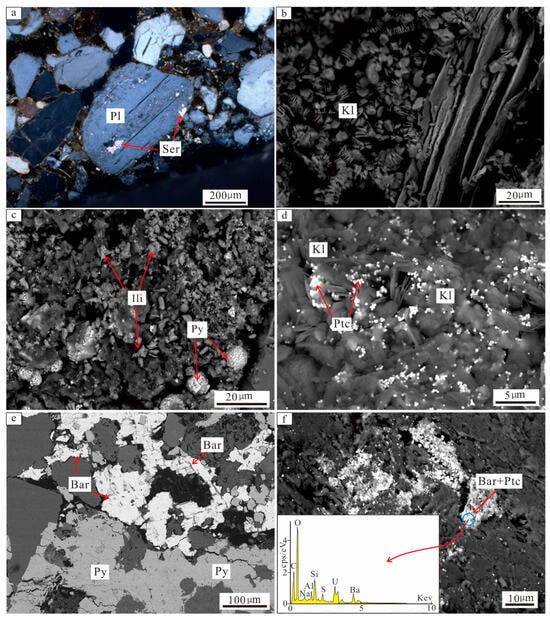
Figure 8.
Argillation and baratization characteristics of the Lower Yaojia formation in the Hailijin uranium deposit. (a) The surface of plagioclase undergoes sericitization alteration (cross-polarized light); (b) booklet- and scaly-shaped kaolinite occur in the intergranular pores between clastic particles (backscattered electron image); (c) fine scaly, plate-like kaolinite occurs on the surface of clastic particles or in intergranular pores (backscattered electron image); (d) Microcrystals, microcrystalline aggregates, and nanometer-sized bituminous uranium ore are adsorbed onto the surface of booklet-shaped kaolinite or within its intergranular pores (backscattered electron image); (e) barite replaces interstitial materials and coexists with pyrite in the host gray sandstone (backscattered electron image); (f) in the gray sandstone ore, barite is associated with pitchblende. Bar—barite, Ili—illite, Kl—kaolinite, Pl—plagioclase, Py—pyrite, Ptc—pitchblende, Ser—sericite.

Table 1.
XRD analysis result of the Hailijin uranium deposit.
- (6)
- Baritization
Barite is observed only in the mineralized gray sandstones or gray ores, commonly replacing the matrix of the sandstone or occurring in association with pyrite (Figure 8e). Barite in the ores is often found in association with pitchblende (Figure 8f), which suggests that the formation of barite is closely related to uranium mineralization.
4.2. Alteration Mineral Assemblages
Different rock types exhibit distinct alteration mineral assemblages (Figure 9). In the Hai Lijin uranium deposit, the alteration mineral assemblage of the bright red sandstone is characterized by “hematite + calcite + kaolinite + illite + sericite”, with strong hematitization being the most representative feature. These rocks are typically formed under arid to semi-arid climatic conditions, associated with primary red sedimentary formations [21]. The alteration assemblage of the light red and brownish red sandstones is similar to that of the bright red sandstone but with slightly weaker hematitization. The alteration types of the brownish-yellow and grayish-yellow sandstones are characterized by “goethitization + hematite + kaolinite + illite”, with small amounts of pyrite present in some grayish yellow sandstones. The hematitization in these sandstones is weaker than that in the light red sandstone. The alteration mineral assemblage of the host gray sandstone is characterized by “ankerite + pyrite + kaolinite + illite + sericite + siderite + barite”, with “pyrite + ankerite + kaolinite + barite” being the most typical (Figure 9). The alteration assemblage in ores is similar to that in the unmineralized gray sandstones, but with a notably higher kaolinite content compared to other rock types (Table 1). This shows a trend of decreasing kaolinite content from ores → unmineralized gray sandstones → red sandstones. Furthermore, the gray sandstones and ores often contain hematite spots, which indicate that the gray sandstones may have undergone modification by reducing fluids. The gray sandstones, prior to reduction, may have been of an oxidized nature, with the hematite spots representing remnants of incomplete reduction.
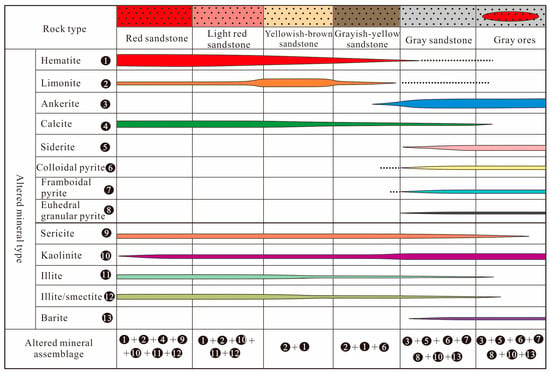
Figure 9.
Alteration mineral assemblages of the Lower Yaojia formation in the Hailijin uranium deposit.
5. Discussion
5.1. Alteration Mineral Formation Sequence
The alteration mineral formation sequence refers to the process by which minerals undergo chemical changes in the surrounding rocks or ores over geological time, leading to the formation of new minerals in a specific temporal and reaction order [22]. Different alteration minerals form during different hydrothermal stages and develop in a progressive relationship based on time or geological conditions. The study of the alteration of mineral formation sequence is crucial for identifying mineralization indicators, analyzing fluid temperatures and pH levels, determining the source of ore-forming materials, and understanding ore deposit genesis [23,24].
The alteration minerals formed during the diagenetic stage primarily include the new minerals formed in the ore-bearing strata sandstones during sedimentation and diagenesis, such as significant amounts of hematite, kaolinite, illite, I/S, and pyrite (mainly II-type and III-type pyrite) in the primary red sandstones formed under arid to semi-arid climate conditions (Figure 10). The alteration minerals formed during the mineralization stage mainly consist of minerals closely related to uranium minerals, generated by fluid-rock interactions during the uranium mineralization phase. These minerals include ankerite, barite, pyrite (mainly I-type pyrite) in the gray sandstones, and ores (Figure 10).
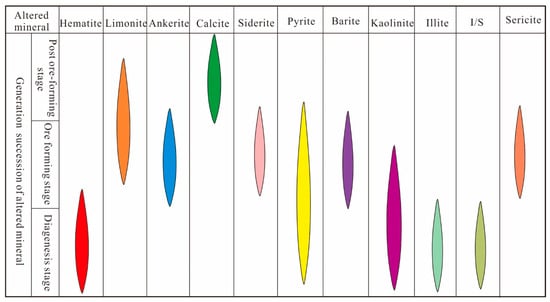
Figure 10.
Alteration mineral generating succession of the Lower Yaojia formation in the Hailijin uranium deposit.
Tian [16] conducted a study on pyrite in uranium-bearing sandstones of the Hailijin uranium deposit. The results indicate that gel-like pyrite (I-type pyrite) exhibits significantly higher concentrations of As, Mo, Sb, and Se in the margin compared to the core (Figure 11). Moreover, elements such as Mo, Ni, Zn, Cu, and Ba show a strong positive correlation with U, suggesting their incorporation during pyrite formation. The concentrations of As, Co, Sb, and Se in pyrite are positively correlated with temperature [25,26], indicating that the ore-forming fluid carrying these metal elements was of relatively high temperature. Regarding sulfur isotopes, the δ34SV-CDT values of pyrite cores range from −2.58‰ to −26.53‰, which are notably higher than those of the margins (−36.50‰ to −49.24‰). This variation is closely related to the influence of deep-seated reducing fluids [16]. In the early stages, sulfate (SO42−) enriched in heavy sulfur within formation water was reduced by anaerobic bacteria and reacted with Fe2⁺ ions in the fluid to form pyrite cores enriched in heavy sulfur. As deep-seated reducing fluids migrated into the ore-hosting strata, the predominant source of H2S shifted to deep fluids, which were biogenically derived and thus enriched in the lighter sulfur isotope 32S. With the continuous influx of deep-seated reducing fluids, the δ34SV-CDT values of pyrite became increasingly negative, resulting in a distinct pattern where the core exhibits higher δ34SV-CDT values than the margin. Based on this, it is inferred that the Hailijin uranium deposit underwent modification by deep-seated reducing fluids during uranium mineralization. Some of the colloform pyrite (Type I) present in gray sandstone and uranium ore was formed during this mineralization stage (Figure 10). Furthermore, the genesis of barite is closely associated with pyrite mineralization. High-temperature, deep-seated reducing fluids rich in H2S interacted with abundant Ba2⁺, leading to the formation of barite. Additionally, the southwestern Songliao Basin experienced extensive mafic magmatic activity during the Eocene (50–45 Ma). The emplacement of magmatic hydrothermal fluids may have released significant amounts of H2S, which subsequently reacted with Ba2⁺, resulting in the formation of hydrothermal barite.
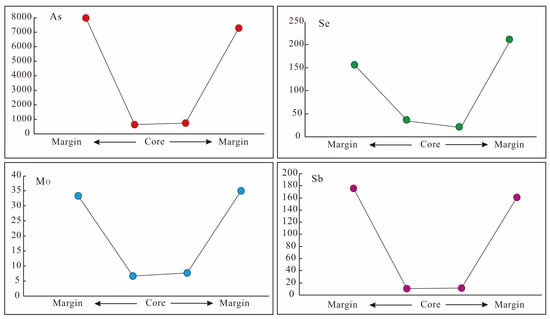
Figure 11.
Diagram of trace element variations in zoned-structure pyrite. Trace element data of pyrite cited from reference [16].
The content of kaolinite in gray sandstone and ore of the Hailijin uranium deposit is significantly higher than in other rocks (Table 1). Micrometer-scale pitchblende is commonly observed adsorbed onto the surface of kaolinite or within its intergranular pores (Figure 8d). Generally, kaolinite typically forms in acidic environments under warm and humid climatic conditions; however, the arid climate of the Yaojia period in the study area was unfavorable for its formation. Instead, such conditions would have been more conducive to the formation of illite or I/S. This suggests that the anomalous enrichment of kaolinite in gray sandstone and ore is not a direct response to the paleoclimate. Moreover, due to their larger specific surface areas compared to kaolinite, montmorillonite and illite exhibit much stronger uranium adsorption capacities. However, pitchblende in the Hailijin uranium deposit shows a close paragenetic association with kaolinite. Based on this observation, it is inferred that the anomalously high kaolinite content in gray sandstone and ore resulted from epigenetic processes. Specifically, during the uranium mineralization stage, the ore-bearing sandstone underwent at least one episode of modification by slightly acidic fluids derived from deeper strata. Therefore, this portion of kaolinite is attributed to mineralization-stage formation (Figure 10).
Alteration minerals formed after the mineralization stage mainly consist of calcite cement filling the intergranular pores of the clastic particles in the red sandstones (Figure 10). Overall, the alteration minerals during diagenetic stage include hematite, clay minerals, II-type (framboidal pyrite) and III-type pyrite (euhedral granular pyrite). The mineralization-stage alteration minerals comprise ankerite, barite, some I-type pyrite, minor kaolinite. Post-mineralization alteration minerals are predominantly calcite cement filling the intergranular pores in the red sandstones (Figure 10).
5.2. Alteration Zonation
The Lower Yaojia Formation of the Hailijin uranium deposit is characterized by a red-mottled sedimentary sequence, with the uranium orebody occurring in the gray sandstone within this sequence. The gray sandstone is surrounded by red-mottled oxidized sandstones in layered, lens-shaped, or nodular forms (Figure 4). This spatial distribution pattern does not conform to the principle of normal sedimentary facies sequence continuity. In other words, the relationship between the gray sandstone and the red-mottled sandstone cannot be easily explained by conventional sedimentary stratigraphy. Field observations of drill cores reveal that the gray sandstone often exhibits enclosed or bay-shaped contacts with red sandstone (Figure 12a), and gray sandstone pebbles or gray mud pebbles are observed within the red sandstone (Figure 12b). This suggests that the red sandstone has been incompletely modified by reducing fluids, which aligns with the characteristic occurrence of hematite spots in the gray sandstone (Figure 5d). Due to the inherent compactness and low permeability of the red mud pebbles, they exhibit gray-green fringed structures in the surrounding sandstones with better permeability, which is the result of modification by deep reducing fluids (Figure 12c). Additionally, the gray sandstone often contains gypsum, a mineral indicative of arid to semi-arid climatic conditions (Figure 12d), suggesting that prior to alteration, the gray sandstone was originally formed under arid to semi-arid conditions as red sandstone. In the same drill hole, the color of the Lower Yaojia Formation sandstone typically transitions from bright red at the base to the gray sandstone, with varying degrees of light red, reddish-yellow, and grayish-yellow sandstones between them (Figure 12e). These rocks also reflect the incomplete modification by reducing fluids, although their alteration is less intense than that of the gray sandstone due to the limitations of fluid driving force and fluid end effects.
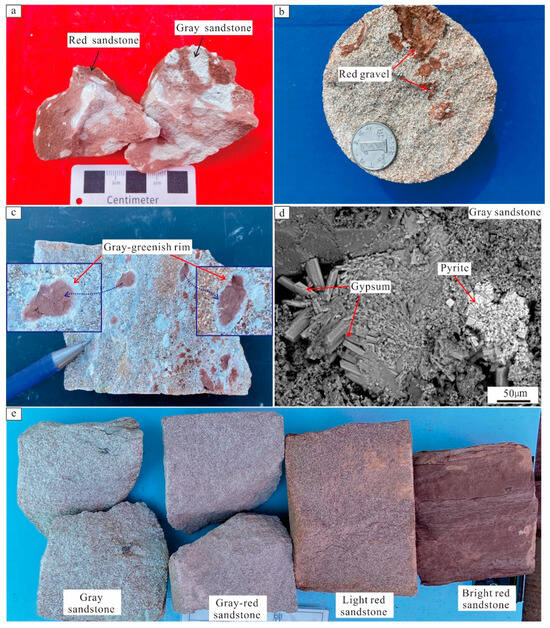
Figure 12.
Petrological characteristics of ore-bearing sandstone in the Hailijin uranium deposit. (a) the red sandstone and gray sandstone are in an encapsulated and embayment-like contact; (b) red mud clasts are observed within the gray sandstone; (c) red mud clasts within the gray conglomerate exhibit a gray-green rim structure, indicating alteration by reducing fluids; (d) gray sandstones often contain gypsum, a diagnostic mineral indicative of arid to semi-arid climatic conditions, this suggests that the gray sandstones were originally primary red sandstones prior to reduction; (e) in the same sand body of the Lower Yaojia Formation, the rocks transition from bright red at the base to gray upward.
Based on the above petrographic and mineralogical analysis, it is proposed that the ore-bearing sandstone of the Hailijin uranium deposit underwent alteration by reducing fluids from deep strata during the uranium metallogenic period. The gray sandstone is likely the direct product of this reduction and modification of the primary red sandstone by reducing fluids. Consequently, primary red zone, weakly reduced pink zone, moderately reduced grayish-yellow zone, and strongly reduced gray zone were identified in the Hailijin uranium deposit (Figure 13).

Figure 13.
Alteration zonation of the Lower Yaojia Formation in the Hailijin uranium deposit.
In terms of major elements, the primary red zone, weakly reduced pink zone, and moderately reduced grayish-yellow zone sandstones are enriched in Fe3⁺ and depleted in Fe2⁺, whereas the strongly reduced gray sandstone and ore exhibit the opposite trend (Table 2). This is consistent with the mineralogical characteristics, where sandstones from the primary red, weakly reduced, and moderately reduced zones appear red, light red, reddish-yellow, and grayish-yellow due to the high Fe3⁺ content. Additionally, the Al2O3 content in the ore is higher than in other rock types, corresponding to the higher content of kaolinite in the ore, which was likely caused by the modification of slightly acidic fluids during the uranium metallogenic period [27,28]. Regarding trace elements, compared to the primary red zone, weakly reduced pink zone, and moderately reduced grayish-yellow zone sandstones, the strongly reduced gray zone sandstones are more enriched in elements such as Mo, Re, V, Pb, Cr, Cu, and Zn, with these elements being even more concentrated in the ores (Table 3). This suggests that during the uranium metallogenic period, elements like Re, Ni, Co, Zn, Cu, V, and Pb were mobilized into the ore-bearing sandstone of the Hailijin uranium deposit. These sulfophilic elements (Pb, Zn, Cu) and elements such as V, Ni, and Co are more likely sourced from deep, higher-temperature fluids, further supporting the involvement of deep reducing fluids in the uranium metallogenic process.

Table 2.
Major element analysis result of the Lower Yaojia formation in the Hailijin uranium deposit (wt%).

Table 3.
Trace element analysis result of the Lower Yaojia formation in the Hailijin uranium deposit (×10−6).
5.3. Discussion on the Genesis of the Deposit
The genesis of sandstone-hosted uranium deposits in the Qianjiadian region of the Songliao Basin has long been a topic of academic debate. Based on a comprehensive study integrating geology, geochemistry, and geochronology, most researchers still consider the primary genesis of the deposit to be interlayer oxidation [7,29,30], proposing a metallogenic model of “multi-stage mineralization, multi-source uranium supply, and tectono-sedimentary coupling”. In recent years, the theory of “deep fluid-mediated mineralization” has gained increasing attention [15,31,32]. Studies have shown that the carbonate cement in the ore-bearing sandstones of the Qianjiadian region has a very low C-O isotope ratio, with most values being negative (δ13CPBD typically less than −20‰) [33]. The sulfur isotope δ34SV-CDT values of pyrite are also characterized by extremely low negative values (ranging from −36.50‰ to −49.24‰) [16,34]. Furthermore, homogenization temperature and salinity analyses of quartz secondary overgrowths and carbonate cements in the ore indicate that the mineralizing fluids had relatively high temperature and salinity [9]. Additionally, numerous oil (gas) inclusions and hydrocarbon components are commonly observed in the ore-bearing sandstones. Gas-phase mass spectrometry studies show that the main carbon numbers of the hydrocarbon components are C17 and C18, indicating that they originate from lower algae-based aquatic organisms. Comparison studies reveal a high degree of correlation between these hydrocarbons and the source rocks of the Lower Cretaceous Jiufotang Formation [35,36], which is also a uranium-rich source rock (with uranium content reaching 10 × 10⁻6) [37]. This suggests that the Jiufotang Formation can provide a deep uranium source for near-surface uranium mineralization.
The Late Cretaceous Yaojia period (K2y, 88–85 Ma) marks the sedimentary diagenesis phase of the ore-bearing strata. The arid-semiarid paleo-climate conditions during this time led to the deposition of primary red sandstone in the Lower Yaojia Formation, with a mineral assemblage consisting of hematite, clay minerals, II-type and III-type pyrite (Figure 9). Meanwhile, the Jiufotang Formation source rocks entered the hydrocarbon generation threshold (90–75 Ma), and uranium-rich reducing fluids began to migrate along the F1 fault into the ore-bearing layers of the Yaojia Formation, leading to the formation of localized uranium mineralization. The U-Pb isochron ages for this mineralization are between 78 and 88 Ma [38]. During the end of Nenjiang period (K2n, 73 Ma), regional compressional inversion triggered a redistribution of pre-existing oil and gas reservoirs in the Lower Cretaceous, while hydrocarbon generation from source rocks peaked [36]. A large volume of uranium-rich reducing fluids percolated into the Yaojia Formation. Due to a sharp decrease in temperature and pressure and a pH change from weakly acidic to alkaline, uranium organic complexes that had previously been stable in the fluid precipitated and formed uranium ore bodies. The U-Pb isochron ages for this period of uranium mineralization predominantly range from 56 to 62 Ma [38]. This phase also corresponds to the large-scale formation of host gray sandstones. The influx of mildly acidic mineralizing fluids led to the dissolution of feldspars, forming book-like and flaky kaolinite, which resulted in higher kaolinite content in the host gray sandstones and ores compared to other rock types (Table 1). At the same time, deeper, higher temperature, mildly acidic fluids rich in CO2 and H2S provided the conditions for the formation of mineralization-related alteration minerals such as ankerite, barite, and pyrite (Figure 9).
Since the Eocene (E2, 50 Ma), regional basic magmatic intrusions brought high-temperature thermal energy, which accelerated the hydrocarbon generation potential of organic matter and promoted the rapid unloading of uranium. As a result, the Eocene mineralization ages (40–48 Ma) likely include hydrothermal alteration effects [38,39]. Furthermore, basic magmatic hydrothermal fluids carried some CO2 and H2S, contributing to the formation of alteration minerals such as ankerite and barite. During the Oligocene–Miocene (33–5 Ma), the Songliao Basin gradually entered a phase of differential uplift, leading to a gradual waning of the effects of basic magmatic thermal events. As such, mineralization during this period (21–29 Ma) is unlikely to have been influenced by hydrothermal alteration.
6. Conclusions
- (1)
- Six types of alteration can be identified in the ore-bearing sandstone of the Hailijin uranium deposit, namely hematitization, limonitization, carbonatization, pyritization, clayization, and baritization. Diagenetic alteration minerals include hematite, clay minerals, II-type (framboidal pyrite) and III-type pyrite (euhedral granular pyrite). Mineralization-related alteration minerals include ankerite, barite, I-type pyrite (colloidal pyrite), and small amounts of kaolinite. Post-mineralization alteration minerals are mainly represented by calcite cement in red sandstones.
- (2)
- The alteration zonation of the Hailijin uranium deposit can be divided into primary red zone, weakly reduced pink zone, moderately reduced grayish-yellow zone, and strongly reduced gray zone. The primary red zone sandstone was formed under arid-semiarid climatic conditions during the Yaojia period. The weakly reduced pink zone, moderately reduced grayish-yellow zone, and strongly reduced gray zone sandstones are the result of varying degrees of reduction by deep-seated reducing fluids acting on the primary red zone sandstone, with the strongly reduced gray zone showing the strongest alteration.
- (3)
- The genesis of the Hailijin uranium deposit is closely linked to the uranium-rich mildly acidic reducing fluids originating from the Lower Cretaceous Jiufotang Formation in the Qianjiadian area. During the uranium mineralization period, these fluids migrated upward along the F1 fault, which traverses the Yaojia Formation strata. With changes in the physical and chemical conditions of the system, uranium unloading, precipitation, and enrichment occurred, ultimately resulting in the formation of multi-layered and tabular-shaped uranium ore bodies.
Author Contributions
Conceptualization, M.T. and Z.L.; investigation, M.T., L.J., J.L. (Jungang Liu), J.N. and J.L. (Jimu Li); writing—original draft, M.T. All authors have read and agreed to the published version of the manuscript.
Funding
This research was supported by the Ye Qisun Science Fund “The Research on the Genesis of Ore-bearing Gray Sandstone in Sandstone-hosted Uranium Deposits (No. U2341292).
Data Availability Statement
Data are contained within the article.
Acknowledgments
We sincerely thank Hanghang He, Shaohua Zhang, and Shusong Ma of No. 243 Geological Party of CNNC for their selfless help in fieldwork and sampling.
Conflicts of Interest
Author M.T., Z.L., L.J., J.L. (Jungang Liu), J.N., and J.L. (Jimu Li) were employed by the company China National Nuclear Corporation (CNNC). The remaining authors declare that the research was conducted in the absence of any commercial or financial relationships that could be construed as a potential conflict of interest.
References
- IAEA. Descriptive Uranium Deposit and Mineral System Models; International Atomic Energy Agency: Vienna, Austria, 2020; pp. 168–199. [Google Scholar]
- Wu, Z.J.; Han, X.Z.; Lin, Z.X.; Li, Z.N.; Ji, H.; Yin, D.F.; Jiang, Z.; Hu, H. Tectonic, Sedimentary, and Climate Evolution of Meso-Cenozoic Basins in North China and Its Significance of Coal Accumulation and Uranium Mineralization. Geotecton. Metallog. 2020, 44, 710–724. [Google Scholar]
- Wang, S.Y.; Cheng, Y.H.; Xu, D.H.; Miao, P.S.; Jin, R.S.; Zhang, T.F.; Xu, Z.L.; Cheng, X.Y.; Zhao, L.; Li, C.H.; et al. Late Cretaceous-Cenozoic Tectonic-Sedimentary Evolution and U-Enrichment in the Southern Songliao Bain. Ore Geol. Rev. 2020, 126, 103786. [Google Scholar]
- Kyser, T.K.; Cuney, M. Geochemistry of Uranium Deposits. Miner. Depos. Can. 2008, 4, 631–678. [Google Scholar]
- Gauthier-Lafaye, F. The Role of Geodynamics in The Formation of Uranium Deposits in Sedimentary Basins. Ore Geol. Rev. 1996, 11, 165–190. [Google Scholar]
- Dahlkamp, F.J. Uranium Deposits of the World: USA and Latin America; Springer: Berlin/Heidelberg, Germany, 2010; pp. 149–233. [Google Scholar]
- Xia, Y.L.; Zheng, J.W.; Li, Z.Y.; Li, L.Q.; Tian, S.F. Metallogenic Characteristics and Metallogenic Model of Qianjiadian Uranium Deposit in Songliao Basin. Miner. Depos. 2010, 29, 154–155. (In Chinese) [Google Scholar]
- Huang, S.H.; Qin, M.K.; Liu, Z.Y.; Zhang, L.L.; Guo, Q.; Jia, L.C.; Jiang, W.J.; Liu, J.L.; Dong, Y. Uranium Occurrence and Metallogenic Age for The DL Uranium Mineralized Belt in Qianjiadian Sag, Southwestern Songliao Basin. Geol. Rev. 2022, 68, 817–830, (In Chinese with English Abstract). [Google Scholar]
- Nie, F.J.; Yan, Z.B.; Xia, F.; Li, M.G.; Lu, Y.Y.; Cai, J.F.; Guo, F.N.; Ning, J. Hot Fluid Flows in The Sandstone-Hosted Uranium Deposit in the Kailu Basin, Northeast China. Geol. Bull. China 2017, 36, 1850–1866, (In Chinese with English Abstract). [Google Scholar]
- Rong, H.; Jiao, Y.Q.; Wu, L.Q.; Wan, D.; Cui, Z.J.; Guo, X.J.; Jia, J.M. Origin of The Carbonaceous Debris and Its Implication for Mineralization Within the Qianjiadian Uranium Deposit, Southern Songliao Basin. Ore Geol. Rev. 2019, 107, 336–352. [Google Scholar]
- Ren, Y.S.; Yang, X.Y.; Hu, X.W.; Wei, J.L.; Tang, C. Mineralogical and Geochemical Evidence for Biogenic Uranium Mineralization in Northern Songliao Basin, NE China. Ore Geol. Rev. 2022, 141, 104556. [Google Scholar]
- Feng, Z.Q.; Jia, C.Z.; Xie, X.N.; Zhang, S.; Feng, Z.H.; Cross, T.A. Tectonostratigraphic Units and Stratigraphic Sequences of the Nonmarine Songliao Basin, Northeast China. Basin Res. 2010, 22, 79–95. [Google Scholar]
- Bonnetti, C.; Malartre, F.; Huault, V.; Cuney, M.; Bourlange, S.; Liu, X.; Peng, Y. Sedimentology, Stratigraphy and Palynological Occurrences of the Late Cretaceous Erlian Formation, Erlian Basin, Inner Mongolia, People’s Republic of China. Cretac. Res. 2014, 48, 177–192. [Google Scholar]
- Chen, M.Y.; Nie, F.J.; Xia, F.; Yan, Z.B.; Yang, D.G. Provenance, Sedimentary Environment, Tectonic Setting, and Uranium Mineralization Implications of the Yaojia Formation, SW Songliao Basin, NE China. Minerals 2023, 13, 1053. [Google Scholar] [CrossRef]
- Tian, M.M.; Li, Z.Y.; Zhang, Y.L.; Jia, L.C.; Ning, J.; Li, J.M.; He, H.H.; Tang, G.L. Genetic Mechanism of Tabular-Shaped Orebody of The Hailijin Sandstone-Hosted Uranium Deposit in The Songliao Basin: Constraints on the Clay Mineralogy of Ore-Bearing Sandstone. Minerals 2023, 13, 1324–1340. [Google Scholar]
- Tian, M.M.; Li, Z.Y.; Zhang, Y.L.; Jia, L.C.; Qiu, L.F.; Xing, Z.C.; Ning, J.; Li, J.M.; Tang, G.L.; Lin, X.B. Trace Element and Sulfur Isotopes Characterisitcs Of Pyrite in Hailijin Uranium Deposit and Their Implications to Ore-Forming Properties, Songliao Basin. Uranium Geol. 2024, 40, 119–128, (In Chinese with English Abstract). [Google Scholar]
- Lin, X.S.; Bao, Y.J.; Zheng, N.X.; Han, H.; Guo, G.R. X-Ray Diffraction Analysis Method for the Relative Content of Clay Minerals in Sedimentary; China National Petroleum Corporation: Beijing, China, 1995; pp. 2–10. (In Chinese) [Google Scholar]
- Yao, F.; Yin, S.H.; Zhou, W.D.; Gao, W.J.; Wei, D.Q. General Rules of Analytical Methods for Scanning Electron Microscope; Ministry of Education of the People’s Republic of China: Beijing, China, 2020; pp. 1–12. (In Chinese) [Google Scholar]
- Lin, C.Y.; Wan, D.R. General Rules for Analytical Scanning Electron Microscopy; State Education Commission: Beijing, China, 1997; pp. 1–5. (In Chinese) [Google Scholar]
- Singh, S.; Awasthi, A.K.; Khanna, Y.; Kumar, A.; Singh, B.; Kumar, A.; Popli, C. Sediment Colour As Recorder of Climate and Tectonics: Cenozoic Continental Red Beds of the Himalayan Foreland Basin in India. Catena 2021, 203, 105298. [Google Scholar]
- Xing, Z.C.; Li, Z.Y.; Wang, H.T.; Jia, L.C.; Ning, J.; Tian, M.M.; Liu, W.S.; Wu, D.K.; Lin, X.B. Characteristics, Genesis and Prospecting Significance of Red Sand Body in the Lower Member of Upper Cretaceous Yaojia Formation, Southwestern Songliao Basin. Uranium Geol. 2023, 39, 987–1001, (In Chinese with English Abstract). [Google Scholar]
- Guilbert, J.M.; Park, C.F. The Geology of Ore Deposits; Waveland Press Inc.: Long Grove, IL, USA, 2007; pp. 170–205. [Google Scholar]
- Titley, S.R.; Beane, R.E. Porphyry Copper Deposits. Part II. Hydrothermal Alteration and Mineralization. Econ. Geol. 1981, 75, 214–236. [Google Scholar]
- Evans, A.M. Ore Geology and Industrial Minerals: An Introduction; Black Science: Hoboken, NJ, USA, 1993; pp. 165–203. [Google Scholar]
- Niu, S.D.; Li, S.R.; Santosh, M.; Zhang, D.H.; Li, Z.D.; Shan, M.J.; Lan, Y.X.; Gao, D.R.; Zhao, W.B. Mineralogical and Isotopic Studies of Base Metal Sulfides from the Jiawula Ag-Pb-Zn Deposit, Inner Mongolia, NE China. J. Asian Earth Sci. 2016, 115, 480–491. [Google Scholar]
- Román, N.; Reich, M.; Leisen, M.; Morata, D.; Barra, F.; Deditius, A.P. Geochemical and Micro-Textural Fingerprints of Boiling in Pyrite. Geochim. Cosmochim. Acta 2019, 246, 60–85. [Google Scholar]
- Song, H.; Ni, S.J.; Hou, M.C.; Zhang, C.J.; Shi, Z.Q.; Wang, G.; Yang, B.; Hu, Y.; Chen, Y.J. The Characteristic of Clay Minerals in Sandstone-Type Uranium Deposit in The Yili Basin, NW China And Its Relationship with Uranium Mineralization. Acta Geol. Sin. 2016, 90, 3352–3366, (In Chinese with English Abstract). [Google Scholar]
- Li, J.G.; Zhang, B.; Jin, R.S.; Si, Q.H.; Miao, P.S.; Li, H.L.; Cao, M.Q.; Wei, J.L.; Chen, Y. Uranium Mineralization of Coupled Supergene Oxygen-Uranium Bearing Fluids and Deep Acidic Hydrocarbon Bearing Fluids in the Qianjiadian Uranium Deposit, Kailu Basin. Geotecton. Metallog. 2020, 44, 576–589, (In Chinese with English Abstract). [Google Scholar]
- Huang, S.H.; Qin, M.K.; Liu, Z.Y.; Xiao, J.; Liu, N. Spatiotemporal Relationship Between Hydrocarbon Fluid and Sandstone-Hosted Uranium Deposits in The Qianjiadian Area, Songliao Basin. Geol. J. 2024, 59, 1148–1170. [Google Scholar] [CrossRef]
- Hu, X.W.; Yang, X.Y.; Ling, M.X.; Xu, J.B.; Du, G.F.; Li, Q.C.; Cao, M.Q.; Wu, Z.J. Mineralogical and Geochemical Studies on The Qianjiadian Deposit, Songliao Basin, Ne China: Insights into Multiple Metallogenic Processes in The Sandstone-Type Uranium Deposit. Ore Geol. Rev. 2024, 168, 106050. [Google Scholar] [CrossRef]
- Li, Z.Y.; Liu, W.S.; Li, W.T.; Li, X.D.; Qin, M.K.; Cai, Y.Q.; Zhang, Y.L.; He, S.; Wu, Q.B.; Qiu, L.F.; et al. Exudative Metallogeny of the Hadatu Uranium Deposit in the Erlian Basin, Inner Mongolia. Geol. China 2022, 49, 1009–1047, (In Chinese with English Abstract). [Google Scholar]
- Qiu, L.F.; Li, Z.Y.; Zhang, Z.L.; Wang, L.H.; Li, Z.C.; Han, M.Z.; Wang, T.T. Characteristics of Organic Matter in Lower Cretaceous Ore-Bearing Sandstones and Its Relationship with Uranium Mineralization in The Northern Ordos Basin. Earth Sci. Front. 2024, 31, 281–296, (In Chinese with English Abstract). [Google Scholar]
- Jia, J.M.; Rong, H.; Jiao, Y.Q.; Wu, L.Q.; Wang, Y.; Li, H.L.; Cao, M.Q. Mineralogy and Geochemistry of Carbonate Cement in Sandstone and Implications for Mineralization of the Qianjiadian Sandstone-Hosted Uranium Deposit, Southern Songliao Basin, China. Ore Geol. Rev. 2020, 13, 103590. [Google Scholar] [CrossRef]
- Chen, M.Y.; Nie, F.J.; Fayek, M. Discussion of The Genetic Relationship Between Pyrite and Uranium Mineralization in Sandstone-Type Uranium Deposits in Kailu Basin. Acta Geosci. Sin. 2021, 42, 868–880, (In Chinese with English Abstract). [Google Scholar]
- Li, H.T.; Wu, S.X.; Cai, C.F.; Luo, X.R.; Bao, R.M. Geochemical Characteristics and Origin of Inclusions and Adsorbed Hydrocarbons in Yaojia Formation Sandstones in Qianjiadian Area, The Kailu Basin. Pet. Geol. Exp. 2008, 30, 375–382, (In Chinese with English Abstract). [Google Scholar]
- Zhao, L.; Chen, H.; Cai, C.F.; Jin, R.S.; Wei, J.L. Geochemical Characteristics of Hydrocarbons in Ore-Rich Sandstones in The Qianjiadian Uranium Deposit, Southwestern Songliao Basin. Geol. Bull. China 2022, 41, 498–508, (In Chinese with English Abstract). [Google Scholar]
- Guo, R.B. Assessment of Shale Oil Potential and Predication of Movable Oil of The Upper Jiufotang Formation in Ludong Sag, Kailu Basin. Ph.D. Thesis, China University of Geosciences (Beijing), Beijing, China, 2020; pp. 25–32, (In Chinese with English Abstract). [Google Scholar]
- Zhang, M.Y.; Zheng, J.W.; Tian, S.F.; Xia, Y.L.; Liu, H.B. Research on Existing State of Uranium and Uranium Ore-Formation Age at Qianjiadian Uranium Deposit in Kailu Depression. Uranium Geol. 2005, 21, 213–218, (In Chinese with English Abstract). [Google Scholar]
- Wang, C.D.; Hao, X.F.; Yang, D.G.; Ning, J.; Wong, H.J.; Yan, Z.B.; Zhang, S.H.; Wu, F. Cenozoic Diabase and Its Relation to Metallization of Sandstone Type Uranium Deposit in Southern Songliao Basin. J. Jilin Univ. (Earth Sci. Ed.) 2023, 11, 53. [Google Scholar]
Disclaimer/Publisher’s Note: The statements, opinions and data contained in all publications are solely those of the individual author(s) and contributor(s) and not of MDPI and/or the editor(s). MDPI and/or the editor(s) disclaim responsibility for any injury to people or property resulting from any ideas, methods, instructions or products referred to in the content. |
© 2025 by the authors. Licensee MDPI, Basel, Switzerland. This article is an open access article distributed under the terms and conditions of the Creative Commons Attribution (CC BY) license (https://creativecommons.org/licenses/by/4.0/).